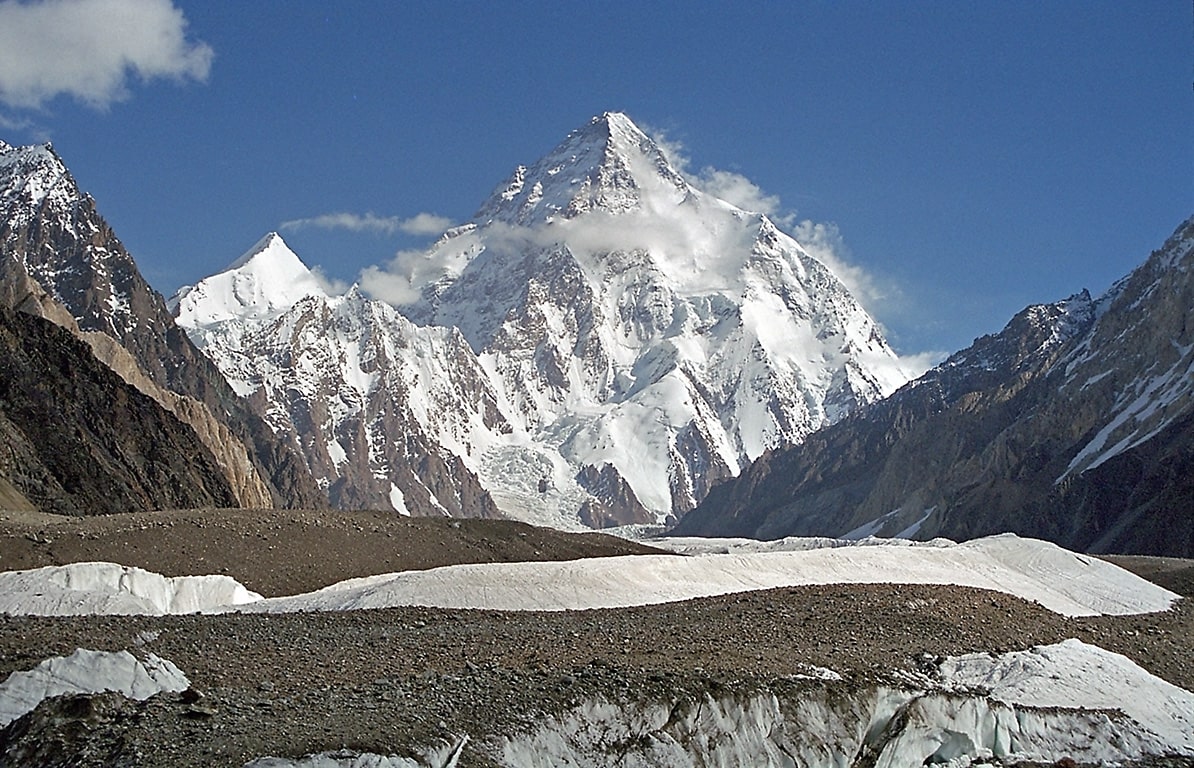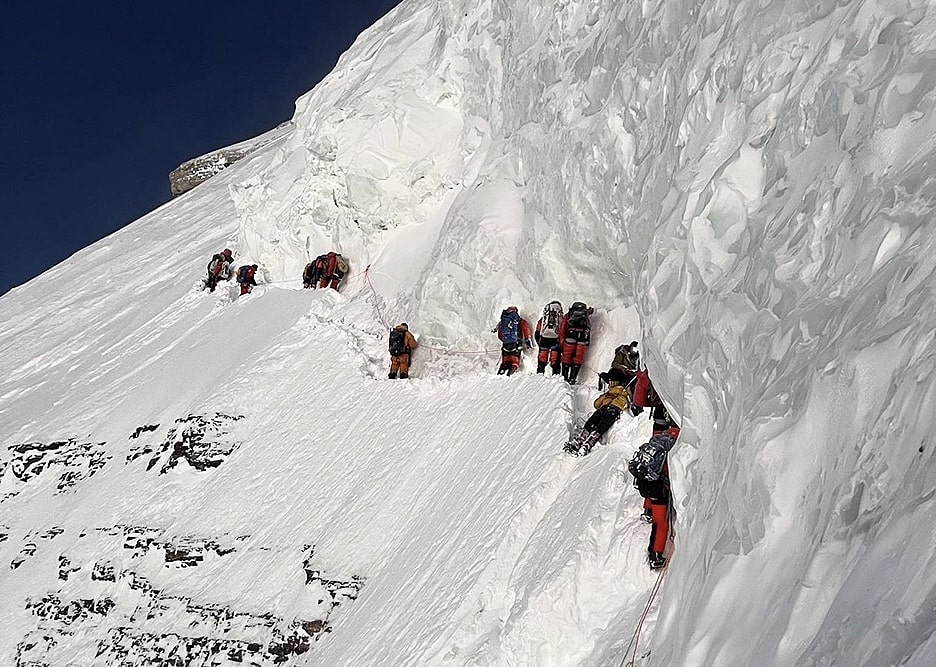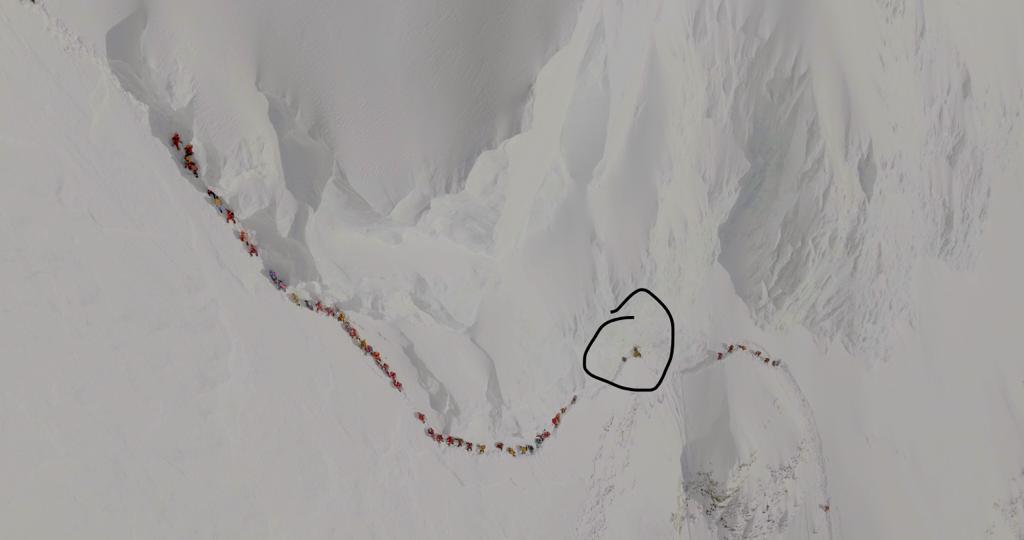
K2 is the second-highest mountain above sea level, with an altitude of 8,611m/28,251ft. However, it is known to be more difficult to climb than Mount Everest. Unlike Everest, K2 is not located in the Himalayas but further north at the Chinese/Pakistani border in the Karakoram range, making the climate colder and the snow deeper. Its steep faces and extreme weather make climbing infinitely more dangerous, which is why the peak is often referred to as the ‘Savage Mountain.’
From the first recorded death on K2 in 1939 by American socialite Dudley Wolfe until February 2021, only 377 people had completed the summit, while a staggering 91 had died trying.
It took until 1954 for the first successful ascent of K2 by the Italian team consisting of Achille Compagnoni and Lino Lacedelli, who returned with severe frostbite from their summit. A subsequent successful second attempt was not made until 1977 by a Japanese team, which was well-equipped and funded by those days’ standards.
Since February 2021, annual permit numbers for K2 have dramatically increased. In the summer of 2021, an estimated 60 people climbed K2, and in 2022, Pakistan issued 207 permits, which was a record. This year, estimates vary but hover between 200-250 permits for the summer climbing window. Summit of K2 is also possible from the Chinese side, but China, by comparison, issues a minimal amount of permits, as the face from China is extremely difficult. Irrespective of the exact number, from 2021-2023, the number of permits has easily doubled from February 2021.
On July 22, 2022, over 145 climbers summited in a single 24-hour period, more than 2.5 times the number of people who had climbed K2 in the previous record year, 2018, when 62 reached the summit in the two-month climbing window. That day, climber and blogger Alan Arnette wrote on his blog. “The Everest model is now official [sic] on K2. […] I wrote that K2 would never become Everest in a blog in 2016. I was wrong.”
The early climbing years gave K2 a death rate of nearly 25%, but the recent commercial exploration of K2 and massive increase in permits issued has significantly reduced the death rate. The recent blow-out in permits means that the number of successful summits must be close to doubling, while there were only five recent deaths in that same period. This has resulted in K2’s overall death rate almost halving, now around 13%.
Many alpinists have criticized the recent increase in climbing permits. K2 is difficult from both the technical aspect as well as weather conditions. The difficulty used to deter amateur climbers, but this fear has abated post-Covid. Experienced mountaineer Alan Arnette had warned in his blog in the past about “dangerous sections that lend themselves to traffic jams, like the Bottleneck Couloir.”

This Bottleneck Couloir Arnette mentioned, has become the site of a much-publicized and debated climbing death, that of Mohammed (or Muhammad) Hassan. On July 27, 2023, the Pakistani porter fell or was struck by an avalanche and later died at the Bottleneck Couloir. As you can see from the pictures, the couloir is barely wide enough for one roped person to pass with much difficulty.
Norwegian world record holder Kristin Harila climbed K2 that same day and received thousands upon thousands of comments on her social media account. Many are attacking the Norwegian climber for not doing more when she has publicly explained the circumstances and that her team tried for hours to help. While it is awful that this young man died on K2, the fault cannot be laid with Harila, her team, or any other climber that day. Climbing K2 means taking into account the possibility of death. It is also important to understand that a rescue from this point would have been near impossible as an estimated 50 if not more, climbers made their way up. Having dozens of climbers from multiple climbing groups turn around on a single track and forcing them back down again would have been impossible and dangerous for everyone involved.
Furthermore, from all accounts that have been made available, Hassan had been advised on numerous occasions that he was not dressed for the climb nor equipped with the right gear and told to turn around. Why he was dressed in inadequate gear and why he did not turn around when told to do so is, at this point, unclear. It needs to be investigated; however, what can be said is that the recent commercialization of K2 has contributed to his death. If the Bottleneck path had not been clogged with climbers, and his climbing company had not pushed or encouraged an inexperienced porter to summit to an altitude he had not been to before, this accident would not have happened this way.

Austrian Wilhelm Steindl and German Philip Flämig had aborted their climb earlier that day but had used a drone to film the day on K2. When reviewing the footage, the pair were shocked to watch people stepping over the porter rather than helping him, “This wouldn’t happen in the Alps,” Philip Flämig was quoted. Steindl started a GoFundMe campaign to support Hassan’s widow and three children. Steindl insists a rescue would have been possible, but no one at the scene knew how to.
The future of extreme altitude climbing needs to be revisited. Revenues from climbing permits cannot be put above human life. Climbing K2 will set you back anywhere between $20,000 – 50,000, depending on the number of sherpas and gear you need to hire. The permit alone for a 5-person climbing team is $12,000. It is a lucrative business for Pakistan, but when it comes at the cost of humanity, it is a cost that is very hard to justify.
The same issues are revisited every year regarding high altitude mountaineering. Follow the money nothing is going to change but rather it will get worse. These people know and accept the fact that they may not return. Some simply should not be there period.